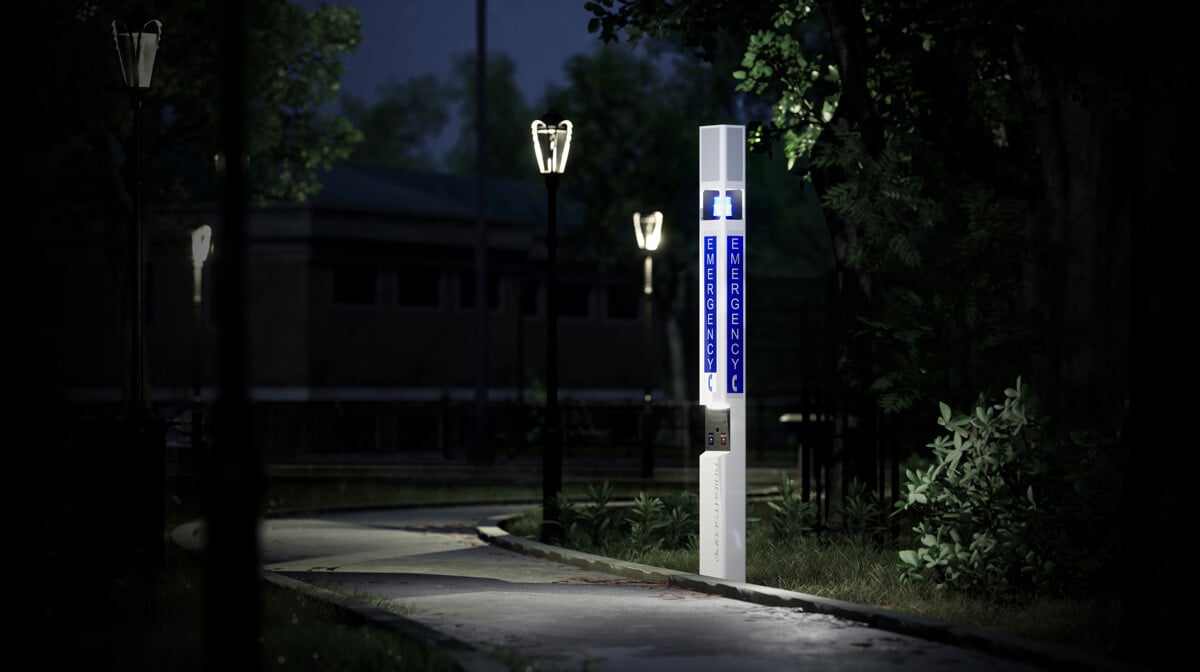4 min read
Avoid the $60K Mistake: Smarter Ways to Upgrade Emergency Towers
 William Santana Li
April 1, 2025
William Santana Li
April 1, 2025

Imagine you're in charge of safety at a busy hospital, school, or casino. You realize you need another emergency blue light tower installed. Simple enough, right? Not quite. The estimate comes back at a jaw-dropping $60,000. You read that right—$60K for just one tower.
Unfortunately, this isn’t an unusual story. Many businesses and public organizations face similar sticker shock when they try to modernize their emergency communication systems. But it doesn’t have to be this way. Smarter options exist that protect both your budget and your people—if you know where to look.
Understanding the true cost of emergency tower replacement

When considering a brand-new emergency tower, it's easy to underestimate the real costs involved. Typically, a fresh tower runs around $15,000 to $20,000. But that’s just the sticker price. Hidden expenses quickly add up:
-
Trenching and infrastructure: To lay down power and communication lines, you might have to dig extensive trenches. Depending on your site, this can be extremely costly and time-consuming.
-
Labor and equipment: Installing a tower isn't a one-person job—it might involve cranes, specialized technicians, and multiple teams working several days.
-
Project disruption: During installation, your location might experience disruptions. Sidewalks close, parking areas become inaccessible, and customers or employees get frustrated.
Suddenly, that $20,000 tower balloons into something much bigger, like the casino’s $60,000 quote.
“Retrofit vs. Replace” — making the smarter decision
Before you commit to tearing everything out and starting from scratch, you should consider another option—retrofitting. Here's what that means in simple terms:
-
Replacing: You rip out the entire old emergency tower or call box and install a completely new one, from top to bottom.
-
Retrofitting: Instead of replacing the whole thing, you simply swap out the electronics—the "brains" of the tower—and keep the existing tower structure.
Retrofitting is faster, more affordable, and far less disruptive. But how do you know if it's the right choice for you? Two simple questions help:
-
Are your towers in the right places today? Locations can change dramatically over 10 or 20 years. Make sure your towers still align with current safety needs.
-
Can your existing infrastructure support modern upgrades? If the towers themselves aren't falling apart, retrofitting might be the smartest, simplest way forward.
Cut costs without cutting corners
Retrofitting emergency towers isn't about taking shortcuts. It's about making smart upgrades that don't blow your budget. Consider these advantages:
-
Lower costs: A typical retrofit costs under $5,000 per tower. Compared to a full replacement (up to $20,000 plus installation), retrofitting is significantly cheaper.
-
Less downtime: Retrofits are quick. Teams can upgrade 30 or 40 units within just a week, minimizing downtime and disruption.
-
Minimal infrastructure changes: Forget expensive trenching and cranes. Retrofitting often only involves a technician swapping out internal parts—simple, quick, and efficient.
-
Refresh and renew: Retrofits can also include cosmetic upgrades like fresh paint and new signage. This gives the towers a fresh look without the hassle or expense of a complete replacement.
-
Bottom line: Retrofitting isn’t a compromise—it’s just a smarter way to invest your resources wisely.
The risks of staying with outdated infrastructure
Sticking with your old emergency towers and hoping for the best isn't just shortsighted—it can be dangerous. Consider these real-world scenarios:
-
Federal facility failure: At one government location, an incident exposed that all six emergency call boxes were offline, leaving a victim helpless during a crisis. Imagine the fallout and liability involved.
-
Bad press & legal trouble: Outdated equipment failing during an emergency can quickly lead to headlines, lawsuits, and damage to your organization's reputation.
Beyond these nightmare scenarios, practical issues loom:
-
Telecom changes: Telecom providers like AT&T are rapidly phasing out traditional phone lines. In a few short years, maintaining these outdated lines will become impossible, leaving legacy towers unusable.
-
Skyrocketing maintenance costs: As old tech gets phased out, replacement parts get harder (and pricier) to find. The longer you wait, the more expensive keeping the old system running becomes.
The new standard: solar, cellular, and smart

Fortunately, there’s a clear path forward—one that brings emergency towers up to modern standards without the headaches of outdated tech. The new standard in emergency communication is built around three simple but powerful concepts: solar power, cellular networks, and smart technology.
-
Solar power: Towers that rely on solar energy eliminate costly trenching for power lines. They also provide reliability, even if your primary power goes down during an emergency.
-
Cellular networks: Modern towers use cellular technology instead of old phone lines. Cellular networks are faster to set up, cheaper to maintain (often half the monthly cost of traditional phone lines), and more reliable, especially during disasters or heavy network traffic.
-
Smart monitoring systems: Platforms like the Knightscope Emergency Management System (KEMS) automatically check your tower’s health daily, eliminating the outdated practice of manual button checks. This guarantees your equipment works when someone needs it most.
Knightscope, for example, partners with providers like Verizon Frontline, offering priority emergency calling. In other words, when you need to make an emergency call, it gets through—no matter how crowded or chaotic the network becomes.
Better technology means safer communities
This isn’t just about technology—it’s about keeping people safe. Modern, reliable emergency towers don’t just connect people during an emergency; they actively prevent crime.
Consider these results:
-
A university in Texas installed 80 new emergency blue light phones across campus and saw burglaries drop by 68%. The simple presence of functioning towers deterred crime, making students and staff feel—and actually be—safer.
-
Emergency towers aren’t just for immediate threats. They’re frequently used to report suspicious behavior, deterring potential incidents before they happen.
-
Unlike cell phones, emergency towers provide exact location tracking (latitude and longitude), so responders know precisely where help is needed, even if the person calling is unable to communicate clearly.
Bottom line: Smart emergency towers don’t just respond to crime—they help stop it.
How to take the first step (without the headache)
You might be convinced that upgrading is smart—but still worried about navigating complicated bidding processes, approvals, or technical questions. Here’s the simple truth: the earlier you talk to an expert, the easier this gets.
-
Start before the RFP: Instead of writing a request for proposals (RFP) assuming a costly full replacement is your only option, bring vendors into the conversation early. Knightscope can help you include smarter retrofit solutions from the beginning, saving significant time and money.
-
Quick evaluations: Getting started is as easy as snapping a photo of your existing towers and sending them in for a free assessment. You’ll quickly find out if retrofitting is a good fit.
-
Simple, transparent quotes: Within days (sometimes hours), you’ll know exactly what the project will cost—no surprises, no confusion, and no unnecessary hassle.
-
Don’t wait until it’s too late
In a world where emergencies are unpredictable but inevitable, one thing you can control is how prepared you are. Ignoring aging or failing emergency towers puts your organization at serious risk—financially, legally, and morally.
Don’t let outdated technology become your $60,000 (or worse) mistake. The smarter choice—retrofitting—is affordable, fast, and proven to keep people safe. Act now, because waiting for the inevitable breakdown is simply not worth the risk.
Ready to explore smarter solutions? Connect with Knightscope and start protecting your community — without overspending.